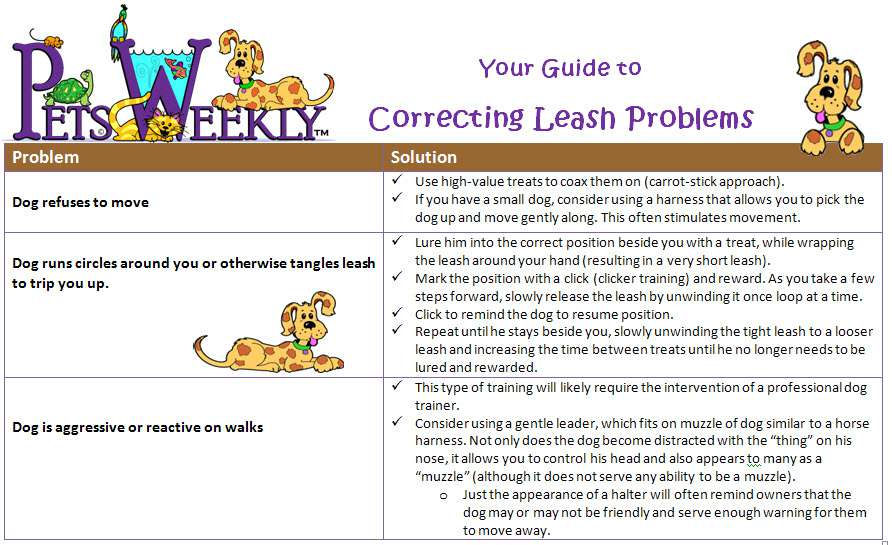
Proper leash etiquette also helps insure that should anything happen to you, your pet will more easily be adopted and treated well in a new home. But beyond that “worst case” scenario, it’s important for your own sanity to have a well-behaved dog on leash. No one wants to walk a dog that pulls or lunges or is otherwise annoying while you are out and about.
And so, here is a quick guide on how to train your dog to leash, as well as a look at the more common problems (and solutions) to more challenging behaviors.
[heading style=”modern-2-blue” heading=”h1″ color=”#996633″ align=”left”]Find Your Dog’s Motivation[/heading]First, it’s important to find their most valued incentive for performing. You can try a variety of things from treats to toys. Once you identify what motivates your dog, you can begin training your dog. Every dog has an item he can’t do without. For some dogs, that’s a ball or favorite toy. For other dogs, it’s a “high-value” treat. Once you find your dog’s greatest source of motivation, you can begin training.
[heading style=”modern-2-blue” heading=”h1″ color=”#996633″ align=”left”]Tire Your Dogs Out[/heading]If you have easily-excitable, highly-reactive dog, the most important thing to do is get them good and tired prior to beginning leash-training. You may want to play a game of fetch in the yard, or just let them run the yard for an hour. Once your dog is tired, he will be much more receptive to training.
Note: Don’t use your “motivation” (ball, treats) during this time. Save the rewards for when they are doing something you want them to do.
[heading style=”modern-2-blue” heading=”h1″ color=”#996633″ align=”left”]Begin the Process[/heading]There are many different schools of thought on training, but this is the way we do leash training:
- Begin each training session with your pet’s “motivation” in an easily accessible pocket or fanny pack. Keep your treat hand free at all times.
- It’s traditional to keep your dog on your left, but you should really choose which side is most comfortable for you and your dog. Some dogs will also be more responsive if you allow them to a looser leash. That may mean your dog is in front, behind or on the side – but as long as they react to slight leash adjustments, they’re fine. You want them to be happy as well.
- Start by attaching your dog to a rope or leash that is 10-20 feet long (but not retractable) while he is wearing a standard collar (avoid choke and prong collars).
- Begin your practice in an enclosed area (such as a fenced yard). You’ll want to reward your pet as they walk, so keep your treats handy.
- Walk forward at a brisk pace, keeping your dog at your side. Each time he is doing something exactly as you wish, reward him with a treat. If they tend to lie down or stop while eating, you may want to consider an alternate form of reward (such as a ball). This is a “carrot-stick” approach to training.
- Walk at a quick pace. This will help minimize distractions and keep your pets focused on you.
As you build up you and your pets confidence, you can increase the walking times. As you practice, your dog will become more focused and will be distracted less.
[heading style=”modern-2-blue” heading=”h1″ color=”#996633″ align=”left”]Perfectionists Need Not Apply[/heading] [bt_quote style=”big-quote” width=”0″]Remember that your dog has the attention span of about a 3-yr-old child, so keep training sessions very short at first. [/bt_quote]For example, you may put the leash and collar on your pet, condition them to wait quietly at door with you, then walk outside to end of driveway and return. Keep in mind that dogs have short attention spans and it’s better to do something right than practice something that is wrong.
Most people run into specific problems. Here are the solutions we use to solve each type of problem.

We believe you can train any type of animal with positive reinforcement. Not only will your dog be more receptive to you and want to please you, but fear-based responses don’t help you or your dog.
For this reason, we recommend you avoid choke collars, prong or pinch collars, and electric collars.
Choke and prong collars can cause serious damage to your pet’s neck and spine, and can even cause collapsed trachea or windpipe damage. These collars have also been associated with thyroid problems, as well as ear and eye issues.
[heading style=”modern-2-blue” heading=”h1″ color=”#996633″ align=”left”]Ask for Help[/heading]You may not have the time to devote to training a dog on the leash. It does require patience, persistence and professionalism. It is much better to ask a trainer to help so you can enjoy your time with your dog.
If you do choose to call in a trainer, remember that you will need to understand the method used to train and be able to apply that method to future walks. Training a dog requires you to be a partner, not a dictator.
